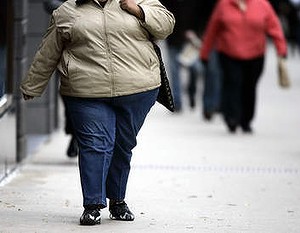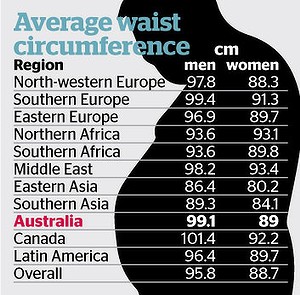
Millions of Australians are obese. Photo: Jeff Haynes
Millions more Australians may be obese than previously thought, because the usual method of measuring obesity has dramatically underestimated the problem.
A study of more than 4000 Australian adults found 27 per cent were obese according to their body mass index, a measure of the relationship between their height and weight. This figure matches the latest estimate for the prevalence of obesity in the Australian population. But when researchers measured the waists of their subjects, they found 49 per cent were obese.
One of the researchers, Anna Peeters, the head of obesity and population health at the Baker IDI Heart and Diabetes Institute, said body mass index (BMI) was usually used to measure obesity because it was more straightforward than measuring waist circumference.

But she said waist circumference was a stronger predictor of health problems such as heart disease and diabetes, and the latest findings showed relying on BMI missed many cases of obesity.
''It shows fairly conclusively that if we only use BMI, we're missing a large proportion of the burden of obesity,'' Associate Professor Peeters said.
''We need to move to population measurements that include waist circumference, even though that's tricky.''
A man is considered obese if he measures more than 102 centimetres around the waist, while a woman is obese if her waist measures more than 88 centimetres.
Because each of the participants in the study was at least 25 years of age, she said the rate of obesity in the general population as determined by waist circumference may be less than 49 per cent, but was likely to be at least 40 per cent.
''The overall burden of obesity is even greater than we thought previously,'' she said.
The Australian Diabetes, Obesity and Lifestyle study tracked its subjects for 12 years.
In 2000, a third were at a healthy weight, but by 2012 only 22 per cent were at a healthy weight. ''The degree of change is quite frightening,'' Professor Peeters said.
Younger adults gained the most weight and showed the greatest growth in their waistlines. Those aged 25-34 gained an average of seven kilograms and seven centimetres on their waist over the period.
Professor Peeters said this showed a greater focus was needed on younger adults, who appeared to be at elevated risk of weight gain.
The findings will be presented at the annual scientific meeting of the Australian and New Zealand Obesity Society in Melbourne on Thursday.



















63 comments
More comments
Comments are now closed